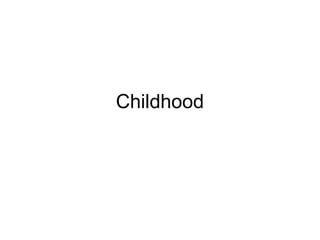
How childhood is socially constructed
- 1. Childhood
- 2. Childhood is socially constructed Socially constructed’ means: -Something that is created and defined by society. -Not fixed but differs between societies and cultures If this is true we can therefore compare our western ideas of childhood with: -the past -other societies
- 3. Childhood is socially constructed Aries (1962) “Our world is obsessed with the physical, moral and sexual problems of childhood. This preoccupation was unknown to medieval civilizations because there was no problem for the middle ages. As soon as he had been weaned, or soon after, the child became the natural companion of the adult.”
- 4. Childhood is socially constructed • In the past Children would have had limited education and would have been a financial asset. • Children would have had to work either inside or outside the family home. • Children would have had more adult responsibilities.
- 5. HOW WOULD YOU DESCRIBE THE CONCEPT OF ‘CHILDHOOD’ IN THIS IMAGE?
- 6. HOW WOULD YOU DESCRIBE THE CONCEPT OF ‘CHILDHOOD’ IN THIS IMAGE?
- 7. Aries’ Conclusion: Children were in effect ‘mini-adults’ with the same rights, duties and skills as adults. For example, the law often made no distinction between children and adults, and children often faced the same severe punishments as those for adults. As evidence of this, Aries uses works of art from the period. In these children appear without ‘any of the characteristics of childhood: they have simply been depicted on a smaller scale.’
- 8. Childhood is socially constructed Stephen Wagg (1992) also validates this belief of Aries… “Childhood is socially constructed. It is in other words, what members of particular societies, at particular times and in particular places say it is. There are no single universal childhood experiences by all. So childhood isn’t ‘natural’ and should be distinguished from mere biological immaturity.”
- 9. Test this theory of social construction… Give 5 words to describe the childhood of the following:
- 10. Childhood is socially constructed Construct an image of ‘childhood’ in the 21st Century in Western Society. What does a 21st century child look like?
- 12. What is the modern western notion of childhood? A special time of life Children are dependent on adults/parents Require a lengthy period of protection, nurturing and socialisation before they become adults. Jan Pilcher (1995) notes that children in our society occupy a separate status from adults.
- 13. Jane Pilcher (1995) ‘Separateness’ Childhood is a distinct life stage with a separate status from adults. How do we distinguish between the 2 life stages? LAWS DISTINCTIVE DRESS PRODUCTS/SERVICES
- 14. (i) LAWS Laws exist to regulate what children are allowed, required or not allowed to do E.g.
- 15. (ii) Dress & Products Children also dress differently to adults and certain products and services are specifically aimed at children. E.g.
- 16. The ‘Golden Age’ of Childhood Childhood in the 21st Century has been referred to as the ‘golden age’ of happiness and innocence. Children are looked on as vulnerable and in need of protection from the adult world –they do not have responsibilities such as paid work, care for children, elderly etc. They are kept in the sphere of family and education – adults provide for them and protect them from the outside world in these areas.
- 17. Reasons for the change in position of Children 1. Laws restricting child labour – excluding children from paid work. Children went from being economic assets to liabilities – financially dependent on parents.
- 18. Reasons for the change in position of Children 2. Introduction of compulsory schooling in 1880. 3. Child protection and welfare legislation – 1889 Prevention of Cruelty to Children Act, 1989 Children Act. Made the welfare of the child the major principle of agencies such as social services.
- 19. Reasons for the change in position of Children • 4. Growth of the idea of children’s rights. United Nations Convention of the rights of the Child outlines basic rights and entitlements of each child.
- 20. Reasons for the change in position of Children 5. Declining family size and lower infant mortality rates. These have encouraged parents to make greater financial and emotional investment in the fewer children that they now have. 6. Laws and policies that apply specifically to children, such as minimum ages for a wide range of activities from sex to smoking reinforced the ideas that children are different from adults, and so different rules must be applied to their behaviour.
- 21. Different cultures construct or define childhood differently Sociologists have attempted to prove childhood as a social construction by comparing it to how children are seen and treated in the different cultures.
- 22. Different cultures construct or define childhood differently • Ruth Benedict (1934) argues that children in simpler, non-industrial societies are generally treated differently from their modern western counterparts in 3 ways. • They take responsibility at an early age. For example, Lowell Holmes’ 1974 study of a Samoan village found that ‘too young’ was never a reason for not allowing a child to take part in a particular task. “Whether it be the handling of dangerous tools or the carrying of extremely heavy loads…if a child thinks he can handle the activity, parents do not object.”
- 23. Different cultures construct or define childhood differently • Less value placed on children showing obedience to adult authority. For example, Raymond Firth 1970, found that among the Tikopia of the western Pacific, doing as you are told by a grown –up is regarded as a concession to be granted by the child, not as a right to be expected by the adult.
- 24. Different cultures construct or define childhood differently • Children’s sexual behaviour is often viewed differently. For example, among the Trobriand Islanders of the south-west Pacific, Bronislaw Malinowski 1957, found that adults took an attitude of ‘tolerance and amused interest’ towards children’s sexual explorations and activities.